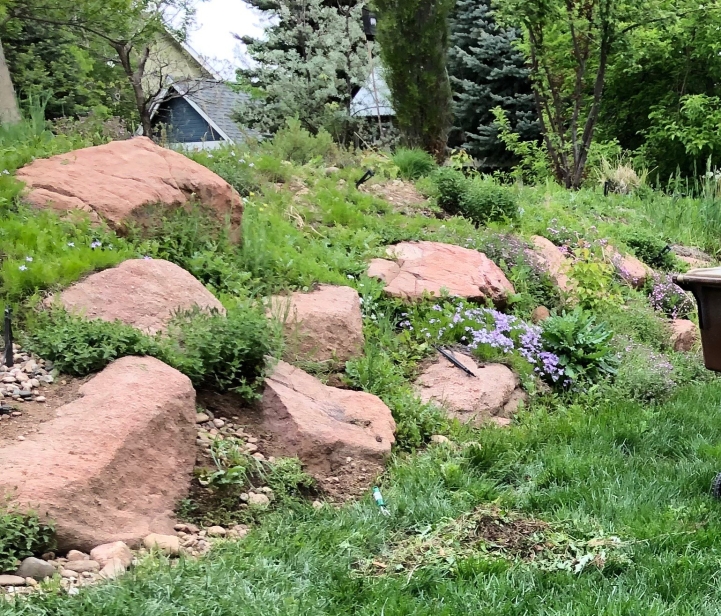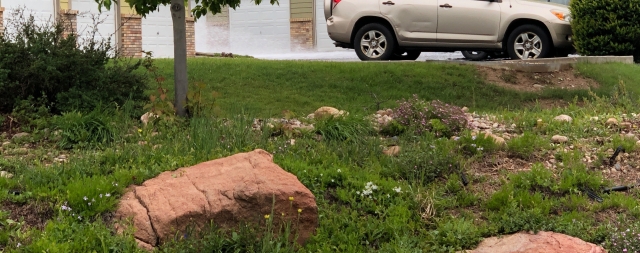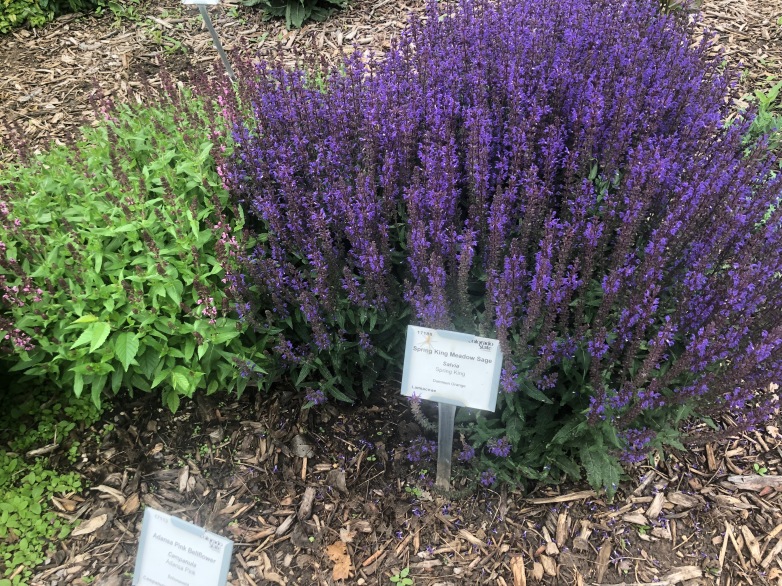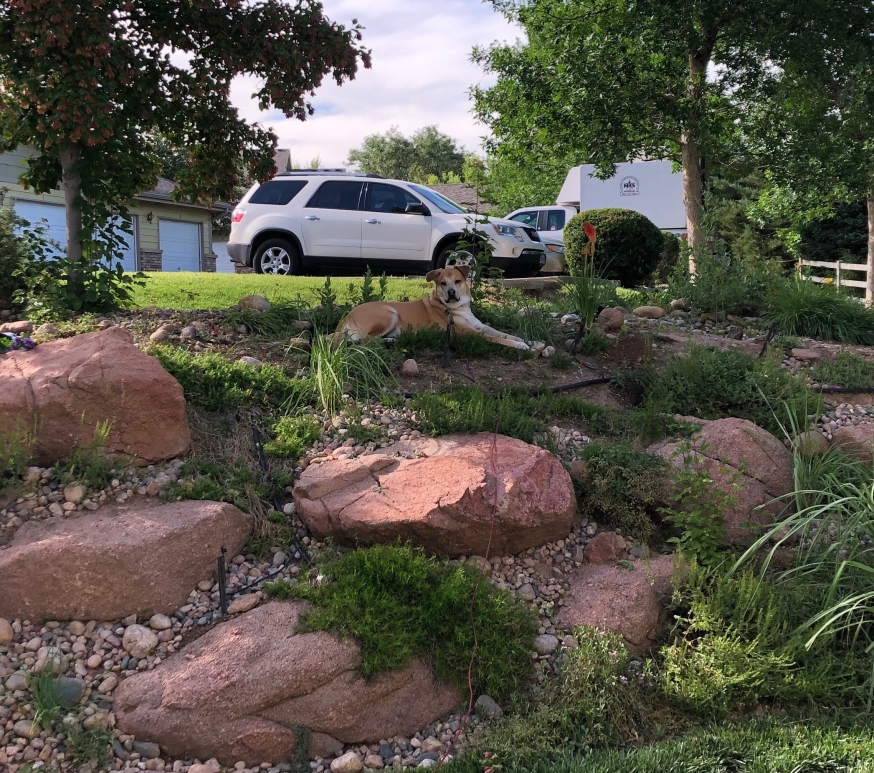I know it sounds naive, but I swear at the start, I thought it was a one-time thing.
Granted, they were everywhere, so I knew it wasn’t going to be simple, or short term.
But, still, I thought if I was thorough, attentive. If I got to the roots. If I spent enough time – in what I came to think of as both my penance, and pleasure – sweating in the often blistering sun – if I was sufficiently dutiful – I would eventually be able to move forward. All the weeds would be eradicated, and my garden would become safe, and regulated – without having to return again, and again, and again.
Before I knew to call it “bindweed,” I saw its ropes wrapped around every little thing in my garden just trying to break free, and survive. There were others, too – what I later learned to call crabgrass, goatsbeard, thistle (mostly Canadian variety), spotted surge, and the wayward starts born of nearby trees, confused about worthy ground.
All of them, a flourishing, interdependent ecosystem of garden colonizers – and we know, no colonizer gives up their territory too easily.
Still, it was beautiful. All of this unruly growth, when you stood back – my garden was robust, alive, with the weeds indistinguishable from intentional plants. Wild, unruly, beautiful.
It had been like that for such a long time, I confess it had started to feel like destiny. Like that was the plan all along. Two full seasons since we moved in, probably many before that. And for each of these seasons, the wild beauty was enough.
I’d even say that sometimes, when I looked out at the great green wall of everything mixed up and running free – it was exquisite.

Wild, exquisite, free. And perfectly low-effort – exactly aligned with what I had time to wish for.
As sabbatical began, I decided I should take a good walk through the garden. Get a closer-up sense of what was actually going on, start to imagine something else, a bigger wish.
It was the first week of May, before anything was in bloom, but already swelling with spring rain, and newly bright sun – the garden was already loud, or really, mostly, the weeds were loud, and pronounced. And the trees, too, pronounced with huge bundles of dead branches weighing down new growth. And in every corner, fallen leaves and peach pits decomposing, and weeds on top of leaves, and rocks in all the wrong places.
So I set out, on a mission. To bring order, clarity, new life. Beginning with understanding what that life would even mean – to learn about each plant on its own terms, with its own impulse towards life, and to see – what is this intending to be, to do? which parts here are plant that we want to save, and which is the invader?

I took many walks through local gardens with handy labels – CSU, Spring Creek – and I googled often.
Once I had a sense, I moved on to the work of liberation – unwind the bindweed, extract the thistles, remove the leaves, move in new rocks, settle everything in, bless it with water, and then, step away to see what would happen.
Although it’s true, there’s a lot of labor at a number of points along the way, equally, gardening is an act of just paying attention – with occasional pep talks, laments, and praise. This is how I ended up with poems like the one that begins, “I found myself apologizing to the peaches again today….”
I bought two pairs of sturdy gloves early in the summer and I used them regularly, and there’s even a couple of well-earned holes in the fingers), but still I mostly preferred to meet the weeds with my bare hands. (Except the thistles. I mean, ouch.)

Which means, I am returning from sabbatical with calloused hands. Calloused, and still dirty-looking, despite many regular and thorough washings.
Sometimes, at the end of the day I would look at my hands and imagine my paternal grandfather, Gus – the smell of his tomato plants, the rhubarb he’d complain was out of control, and the way he pulled the carrots out of the ground and I thought it was a miracle.
Or, my father’s hands after a day in the raspberry bush, or the potatoes, or the annual planters on our deck. The way I learned, not with words exactly, just in the living – how the garden can turn a bad day, or bad week, or bad year of work, or a fight at home, or a checkbook that won’t balance or reveal the money for all the bills that need to be paid – all of these, after a few hours of watering, weeding, re-arranging, witnesssing – can be transformed into joy, and release, and even, purpose.
I know it’s probably too obvious, but it’s still true to say that weeds are a lesson in power. The power to choose what has the right to keep on, to flourish, the power to understand what was worth saving. Or, the power to remain careless and haphazard, to pull up something someone had sometime earlier planted with some great intention.
Even just today I pulled on a particularly interesting weed only to realize from the black well-balanced dirt that came bursting out – it was something I’d planted early in the summer, and had forgotten.
We are always all making this choice – what is worth saving, what matters, what belongs, what we want to feed, what we will leave behind. Some of us have a greater chance to decide, a wider span of control, autonomy, privilege. And still, all of our lives are attempts at this power – in the garden, our homes, our cities, our lives.
For example, for a long time, in the early summer, I decided to let the goatsbeard thrive as part of the garden. The yellow flowers were so tall, proud – it gave some height to an otherwise ground-cover-heavy yard. They asserted their place so particularly, not appearing at all like invaders. And still, when I looked at them, I knew, their time would come – and little by little, they came to look more and more like dandelions, and so I reached down at their base, and dug my fingers into the dirt around them, and pulled them each up, one after another. Like a massacre, or a liberation.
I’m sure not everyone experiences their garden as if a battle – but I could not help, over the season, to begin to know myself as the defender of the plants that were intended to flourish – battling all those that were constantly attempting to squelch this flourishing.

Not just weeds, but hail – late, and devastating.
And squirrels, especially in the late season as the peaches swelled.
Bugs came earlier – i.e. the hungry caterpillars trying to turn into the butterflies who will later pollinate flowers in all the right ways are first a threat to the leaves of those same flowers.
My well-intentioned but still careless dog is both a danger and defender, though probably, in balance, an extremely-well-disguised enemy. And still, his company makes it worth his betrayals: the ways he displaces the rocks on top of the fragile new plant while chasing down a squirrel, or decides the just-cleared out area with a new tall-reaching flower is just the place for an afternoon nap. Mostly, his company, especially attentive when I’m digging, or sitting and staring at it all at the end of the day overrides all of this. Net positive, I swear.

More questionable are my thoughtless and only-occasionally-well-intentioned children -who travel up and down and around my garden without thinking twice. They forgot to notice there’s been a change since the weeds covered it all, forgot to adapt their behavior to find the newly installed steps around either side. I shout at them, plead to be careful of the flowers and they look down and shout out, sheepishly, sorry mom, and then by the next day, forget again.
All this – not to mention the news coming from the border, the President, and the dual massacres in Ohio and El Paso – all had me thinking all summer about danger, and what we do to protect the things we love. This is what happens with such a huge expanse of time, and the chance to listen to all the news, and the brain space to worry about your children and all they may be getting themselves into, and to think back on all that life has brought, and all that has been lost along the way. You can’t help but contend with the fact that danger is everywhere, and grief. No matter how dutiful we may be, how thorough, hard-working well-intentioned, how diligent – there is so much at risk, all the time, everywhere. Not everything can be saved, and barely anything – especially people – can be protected from danger.
To decide to care about something means to decide you’re going to have your heart broken, sooner or later.
I kept thinking – it would be so much easier if I just let the weeds keep on with their takeover. If I cared less, paid less attention.

But then, I would look over at the trees, freed from all their dead branches that had been for so long holding them back, now flourishing – and the path I’d made after all the weeds were cleared that we could walk up to survey it all, and sit under the shade, while the neighbors’ chickens make their daily plea for food or attention – and the phlox offers itself in bright pink, and purple, and white – I didn’t even know those flowers existed before all this began, and yet their potential was there the whole time. The whole time, there was always so much here than I even knew to hope for.
Only this that can keep us from letting the danger take hold – this seeing something beyond what we thought was possible, this stunning surprise of life, this faith in what remains not yet. Only the clearing everything out, the caring for something before you even know what it is, that risk to care, to tend, to feel a part – only this decision to love keeps us going.
I kept on with my plan for much of the first few weeks. Working slowly, dilligently, whole days would pass and I’d hardly made it through a small plot of land. And with each hour, the filling of buckets and buckets of weeds, alternated with re-distributed rocks. And then, throughout the day, I would empty the weeds into the yard waste bins, that over the week would fill, until each Wednesday they would again be full, or over-full, to place on the street – and another week would begin, with hope, and intention.
Weeds, and rocks – these were the truest story of my sabbatical.
It continued like this until early June when I took a trip with my family to the northwest, which meant I left it all behind for nearly three weeks. There was water on it, that wasn’t a worry, I decided it could survive a couple of weeks in early summer, and then I would get back on mission.
The good news was that, it all survived – water does make sure of that. The bad news, or really, just the lesson, was that the water also fed the weeds, and even more so. In fact, the weeds, while I was away, decided it was their time to party / take over. A full resurgence, over every little area that I had considered conquered.
I had no right to believe that one pass would tame all that had been running free for years – but I did believe it, and seeing everything I had so carefully cleared all grown over again, I was devastated. I wondered if I had been wasting my time, or if I would ever move beyond this 20 square foot plot into the rest of the yard- or if I would keep at this one section over, and over, and over.
Every thought I had about danger being everywhere intensified – and instead of just thinking about danger, I started to wonder about nihilism. But then, there was still about 8 weeks left in sabbatical – I had all this time to just, go back, try again. So I did.
Pulling, and moving, and assessing, and blessing. This time it all went much faster, as I realized I knew some things about how the plants should fall, and because I’d been there recently, the soil was quicker to give way when I came for the weeds. Before long, I was moving along to the next section, and the next, and the next.

Along the way, I kept circling back to the prior places, watering the new plants I’d added, reshuffling displaced rocks, finding the bindweed that was so insidious, persistent – sometimes even having the nerve to flower – conceding the impossibility of really ever getting it all.
One particularly problematic section I’d done over three or four times, I finally decided to clear out all the rocks and dig it all up, spread out weed-preventer, and then put down a weed barrer, and then the rocks again, along with a few new plants. We have to vary our strategies, I reminded myself. Keep trying new ways to tend to all this life and these dreams for more.

It’s a set up, you know that, right?
This was the response the minister who led my life review retreat in July asked me when I told her about my work in the garden, and my hope to get it stable – finished – before I would feel ready to go back to work.
It’s a set up, what you’re doing to yourself.
And then we took a walk to the garden right below the window we had been sitting beside.

She and her husband had been gone from home for the first 6 weeks of summer. They returned to find their garden looking like this on all sides. Wildflowers aka weeds had fully interspersed with every flower they’d previously intentionally planted.
Sometimes life looks like this, she said. And sometimes it looks like something more orderly. The work is not to make it all look orderly, and it’s not to give it all up either. The work is to discover in all of it, where the beauty is at any given moment, the joy, and what will be, good enough.
Good enough is not a concept I’ve let myself entertain much – like ever – and even though I wrote it down when she said it, and even agreed to give such an idea a try – I’ve had to turn it around and around since then to begin to understand what she was getting at.
Which is – I think – about coming to terms with our place in life, which is not nothing, and also, not everything. To accept that there are seasons in life, as in the garden, and rhythms. I think good enough means coming to make friends with time – rather than, as I have always done – thinking of time as a problem to be solved.
Good enough means coming to terms with what we can do in day, an hour – or a lifetime. Calling that offering a blessing – whether it turns out to be a garden abundant with weeds and wildflowers (as mine was as well – and it was, in its own way exquisite), or one governed with intention that yields peaches, phlox, hydrangeas, wisteria, sage, daisies, columbines, lilacs and so many others – and fends off any creeping invaders with diligence and fidelity.
Good enough is not to surrender to the danger that threatens all that we love, or pretending it does not exist, but only to know that our best defense must include knowing our own limits, and even our helplessness in a bigger sense – to continue to do our part, regardless, and to give the rest to those who will come next, to the earth, to God.
Good enough feels like a discipline to me, a scary one, sometimes, and a liberating gift most of the time. And, it is a practice I am trying out each day far beyond my garden, far past sabbatical – as my attempt to feel less compelled to hold it all, to refuse to concede to the danger, or to stop noticing them – or the grief – but to stay connected to the beauty, and all that keeps growing, and thriving in my garden – and in this life – far beyond what I ever could have imagined.








Pingback: Telling the Stories of Sabbatical | Another Possibility